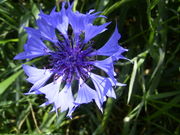
National symbols of Estonia
Encyclopedia
Estonian flag
The current coat of armsCoat of arms
A coat of arms is a unique heraldic design on a shield or escutcheon or on a surcoat or tabard used to cover and protect armour and to identify the wearer. Thus the term is often stated as "coat-armour", because it was anciently displayed on the front of a coat of cloth...
of Estonia
Estonia
Estonia , officially the Republic of Estonia , is a state in the Baltic region of Northern Europe. It is bordered to the north by the Gulf of Finland, to the west by the Baltic Sea, to the south by Latvia , and to the east by Lake Peipsi and the Russian Federation . Across the Baltic Sea lies...
is a golden shield which includes three slim, blue leopards
Leopard (heraldry)
The leopard or lion passant guardant is a frequently used charge in heraldry. It mostly appears in groups of three, which are positioned over each another.-Heraldic and zoological leopards:...
(or lions
Lion (heraldry)
The lion is a common charge in heraldry. It traditionally symbolises bravery, valour, strength, and royalty, since traditionally, it is regarded as the king of beasts.-Attitudes:...
passant guardant) in the middle, with oak branches along the side of the shield.
The heraldic lions of the coat of arms are the most ancient of Estonia's symbols. They have been used since the 13th century, when they served as the big coat of arms for the capital city, Tallinn. Tallinn got these slim blue lions from the King of Denmark, Waldemar the Second; Denmark was the ruling power in Northern Estonia at that time. Tallinn was under Danish rule between 1219 and 1346, and, according to one theory, the name "Tallinn" itself meant originally "Danish castle" (Estonian
Estonian language
Estonian is the official language of Estonia, spoken by about 1.1 million people in Estonia and tens of thousands in various émigré communities...
: Taanilinn); the etymology, however, is by no means certain. Various other foreign powers came and went, but the three lions remained to become the coat of arms for most of the Estonian territory. The State Assembly of the independent Republic of Estonia adopted the three lions officially by its resolution on June 19, 1925.
This coat of arms of the Republic of Estonia was in use until the beginning of the Soviet occupation on June 21, 1940.
The rendering on the coat of arms returned to the public in connection with the national amnesty started in 1988. For the first time since a hiatus that lasted decades, the coat of arms adorned by three lions of the city of Tallinn was used as a historical element in the Old Town Days of 1988. The City Arms of Tallinn was reinstated in the same year.
Symbology
Upon the passing of the Law, proposals were made in the Riigikogu on possible interpretations of the images on the coat of arms. A consensus was reached on the suggestions offered by Leopold Raudkepp:- One of the lions symbolizes the courage of the fight for freedom in ancient times. The second stands for the courage in the uprisings in Harjumaa in 1343. The third represents the courage of the Estonian fight for freedom between 1918-1920.
- The wreath of oak leaves stands for the perseverance and strength of Estonia and the evergreen traditions of freedom.
The national anthem of Estonia
The Estonian national anthem "My Native Land..." is a choral-like melody arranged by Fredrik Pacius, a Finnish composer of German origin, in 1843. In Estonia, Johann Voldemar Jannsen's lyrics were set to this melody and sung at the first Estonian Song Festival in 1869. It gained popularity during the growing national movement. In Finland, the tune first became popular only as a students' song, but soon it also became more widely accepted. When both Estonia and Finland became independent after the First World War, the identical melody with different words was recognized as the national anthem of both nations. Estonia officially adopted it in 1920, after the War of Independence. During the decades of the Soviet occupation of Estonia, the melody was strictly forbidden and people were sent to Siberia for singing it. However, even during the worst years the familiar tune could be heard over Finnish radio; it was played every day at the beginning and end of the program. Thus, the melody could never be forgotten. With the restoration of Estonian independence, the national anthem has, of course, been restored too.During the years of prohibition of national symbols, Lydia Koidula’s poem, ”My Native Land is dear to me”, with a melody by Gustav Ernesaks became a powerful means of expressing national feelings. This was and still is regarded as an unofficial anthem.
Other national symbols
In addition to the three main state symbols, Estonia has chosen her own national flower and national bird. Estonia even has her own national stone and national fish, which seem to be a rarity among other national symbols. All four have gained official status.National flower

The campaign to choose a national flower was organized by The Estonian Wildlife Protection Society. The televised contest was carried out in 1967-68. The ornamental blue cornflower was the favourite. In choosing it, several considerations were taken into account: general popularity, decorative appearance, easy applicability as an artistic motif, and domestic origin.
The cornflower has grown on Estonian soil for more than 10,000 years, from the time when the first humans came to Northern Europe. The plant grows commonly in rye fields, creating a strong connection in the minds of Estonians between the flower and their daily bread. The blossoms of the cornflower have a particularly striking graphic appearance which has led to its use by artists for decorative purposes. The cornflower is also part of the young girls' festive garland. It is possible that the cornflower was chosen as the national flower in 1968 for another important reason. People knew that the blue of the then forbidden Estonian flag was defined as "cornflower blue". This made the cornflower a symbol of resistance in its own way. The Soviet authorities, in a move that is nowadays quite difficult to believe, responded by banning representations of the cornflower. Thus, at the 100th anniversary of the Estonian Song Festival (1969), all the cornflowers used as decorations were painted over with red and presented as "carnations".
National bird
The barn swallowBarn Swallow
The Barn Swallow is the most widespread species of swallow in the world. It is a distinctive passerine bird with blue upperparts, a long, deeply forked tail and curved, pointed wings. It is found in Europe, Asia, Africa and the Americas...
, the national bird, is a characteristic guest of Estonian homes. Its call can be heard from practically every eave or barn rafter in the country. If the bird finds a suitable opening, under the ridge of a roof or a broken window, it will build its cup-shaped nest; it will even build it inside a house. The choice of the barn swallow as a national bird was mainly the result of a campaign conducted by ornithologists at the beginning of the sixties.
National stone
Estonian national stone is the country's valuable grey limestone. Estonia lies on a thick layer of limestone which is visible on the steep banks of northern and western Estonia. Most castles, churches, farm buildings, and countless stone fences are made of limestone. Research on limestone and its well-preserved fossils has for centuries brought Estonian scientists international renown. Perhaps that is one of the reasons why numerous scientists supported the declaration of limestone as the national stone of Estonia.National fish
Estonian national fish is Baltic herring. In the online poll to select a national fish, which attracted 50,000 voters, the pike won by about 500 votes. The group behind the idea was the Estonian National Fishery Association. A panel of judges overruled the vote on the grounds that as a traditional staple of the Estonian diet, the Baltic herring has been more important for more people through the country's history. Baltic herring has been near Estonian coast for 5,000 years.Unofficial symbols
As in any other country, there are a number of other objects in Estonia which have symbolic value without any official decree. Oak, for example, has long been regarded as a sacred tree. Estonia lies in the northernmost zone of its occurrence. Mixed forests with oak have given the country its most fertile humus soil.Oaks are part of pre-Christian beliefs of Estonians. Ancient Estonians planted oaks in their holy places. The supreme god was Taara. He was celebrated in sacred oak forests around Tartu.
Various buildings and their details are regarded as of national value. Among them are the Old Thomas
Old Thomas
Old Thomas is one of the symbols and guardian of the city Tallinn, the capital of Estonia. A weather vane, the figure of an old warrior called Old Thomas was put on top of the spire of Tallinn Town Hall in 1530...
weathervain on the spire of Tallinn's Town Hall; Toompea Castle, together with its mighty watchtower Pikk Hermann
Pikk Hermann
Pikk Hermann is a tower of the Toompea Castle, on Toompea hill in Tallinn, the capital of Estonia. The first part was built 1360-70. It was rebuilt in the 16th century...
and the Hermann Castle
Hermann Castle
Hermann Castle is a castle in Narva, eastern Estonia. It was founded in 1256 by the Danes and the first stone castle was built in the beginning of the 14th century...
on the western bank of the Narva river
Narva River
The Narva is a river flowing into the Baltic Sea, the largest river in Estonia. Draining Lake Peipsi, the river forms the border of Estonia and Russia and flows through the towns of Narva/Ivangorod and Narva-Jõesuu into Narva Bay. Though the river is only 77 km long, in terms of volume...
, which has long constituted a border between the East and the West.
Many of the above-mentioned symbols were represented on coins and banknotes of the Estonian currency
Estonian kroon
In 1992, coins were introduced in denominations of 5, 10, 20 & 50 senti, as well as 1 kroon. The 1 kroon was struck in cupronickel, the others in aluminum-bronze. However, in 1997, nickel-plated steel 20 senti were introduced, followed by aluminum-bronze 1 kroon in 1998. 5 senti coins were not...
. All coins carried the three lions of the coat of arms. The one kroon note beared the image of Toompea Castle. The two kroon note depicted Tartu University. The five kroon note presented Hermann Castle facing the Russian Ivangorod castle
Ivangorod fortress
Ivangorod Fortress is a Russian medieval castle established by Ivan III in 1492 and since then grown into the town of Ivangorod....
on the eastern side of the Narva river. Estonia's mightiest oak was pictured on the ten kroon note and so on. The highest denomination, the five hundred kroon note, carried an image of the barn swallow in full flight.
The symbol of Estonian fight for freedom is the core of the Cross of Liberty, that is widely associated with Estonian War of Independence and World War II
World War II
World War II, or the Second World War , was a global conflict lasting from 1939 to 1945, involving most of the world's nations—including all of the great powers—eventually forming two opposing military alliances: the Allies and the Axis...
.

